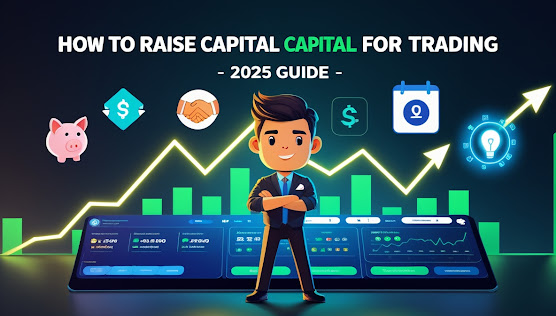Want to start trading but don’t have enough money? Don’t worry, you’re not alone.

Thousands of new traders face this same challenge every day — but the good news is, you can build your trading capital from scratch with the right approach.
In this blog, we’ll walk you through 5 realistic and beginner-friendly ways to build your stock market trading capital — even if you're starting with zero rupees.
💡 Why You Need Smart Capital Before You Trade
Capital is your lifeline in the stock market. Whether you're into intraday trading, swing trades, or long-term investing — having your own reliable source of capital gives you the freedom to:
-
Take better trading decisions
-
Avoid overleveraging
-
Grow gradually without stress
Let’s look at how you can raise capital step-by-step — no matter where you're starting from.
✅ 1. Start Freelancing and Invest Your Earnings
If you're low on capital, the best and fastest way to earn some extra money is through freelancing. Some beginner-friendly freelancing skills you can learn quickly:
-
Content writing
-
Social media management
-
Graphic designing
-
Virtual assistance
-
Data entry
You can join platforms like Fiverr, Upwork, or Freelancer.com to find work and start earning. Even if you earn ₹5,000–₹10,000 a month, save at least 20–30% of it every month.
📈 In 6 months, you’ll have your first ₹10,000–₹20,000 ready to start trading small.
✅ 2. Build a Blog or YouTube Channel Around Trading
If you already have some market knowledge, consider creating content around it.
Start a YouTube channel or blog where you:
-
Share your trading journey
-
Explain basic concepts to beginners
-
Provide market updates, charts, and analysis
Monetization options include:
-
Google AdSense
-
Affiliate links (Zerodha, Upstox, Angel One)
-
Sponsored posts or brand deals
All of this can become a passive income stream — and your capital pool for trading.

✅ 3. Do a Job + Start SIP: Grow Money Passively
If you're working or studying and don’t have time for freelancing or content creation, go for a systematic investment approach.
-
Invest ₹1000–₹2000 every month in a liquid mutual fund or low-risk investment
-
Let it grow for 6–12 months
-
Use the matured amount as your starting capital
🚀 Bonus: It builds financial discipline, which is a trader's best friend.
✅ 4. Join Virtual Trading Competitions for Real Rewards
Many trading platforms like Sensibull, TradingView, or Moneybhai conduct virtual trading contests with real cash prizes.
-
You trade using virtual money
-
If you rank among the top, you get real rewards
-
It builds confidence without risking real money
It’s a smart way to gain experience + earn trading funds at the same time.
✅ 5. Learn. Teach. Earn. Invest.
This is one of the most powerful loops for new traders:
-
Learn trading via books, YouTube, or online courses
-
Document your learnings — turn them into mini-courses, PDFs, or eBooks
-
Sell these on Gumroad, Notion, or social media
-
Invest the profits into your trading account
🧠 This method builds both your personal brand and capital at the same time.
⚠️ What NOT to Do While Raising Trading Capital
-
❌ Don’t take personal loans for trading
-
❌ Don’t borrow money from friends or family
-
❌ Don’t trade with emotions or the need to win fast
-
❌ Don’t fall for “get-rich-quick” crypto or forex scams
Building capital is a slow and smart game — not a lottery ticket.
🔚 Conclusion: Capital Can Be Created, Not Just Inherited
You don’t need to be rich to start trading — but you do need to be resourceful.
By combining freelancing, smart investing, content creation, and learning-based income strategies, any beginner can build a solid trading fund within 3 to 12 months.
So don’t wait for the “perfect capital” — start with what you have, and build as you grow.
📌 SEO-Optimized Meta Details
👉 Title:
How to Raise Capital for Stock Market Trading: 5 Best Ways for Beginners (2025)
👉 Meta Description (Search Description):
Learn how to build your trading capital from scratch as a beginner. Discover 5 proven ways to raise money for stock market trading — from freelancing to smart investing.
👉 Suggested Tags:trading capital, stock market tips, freelancing for traders, trading for beginners, how to start trading, low investment trading



